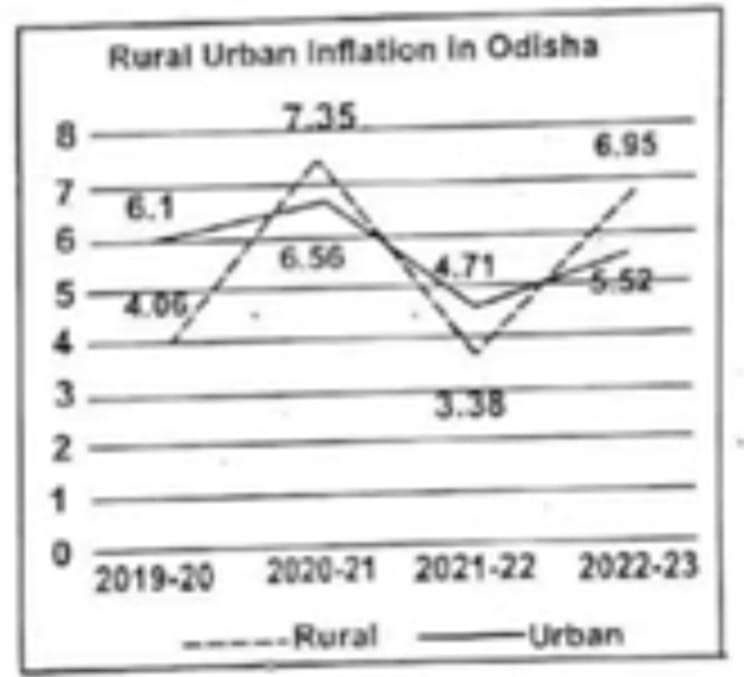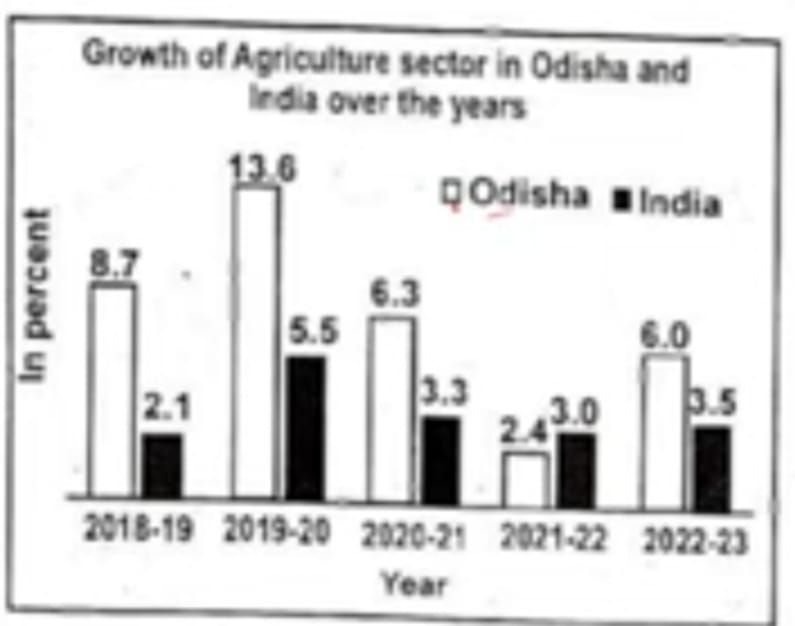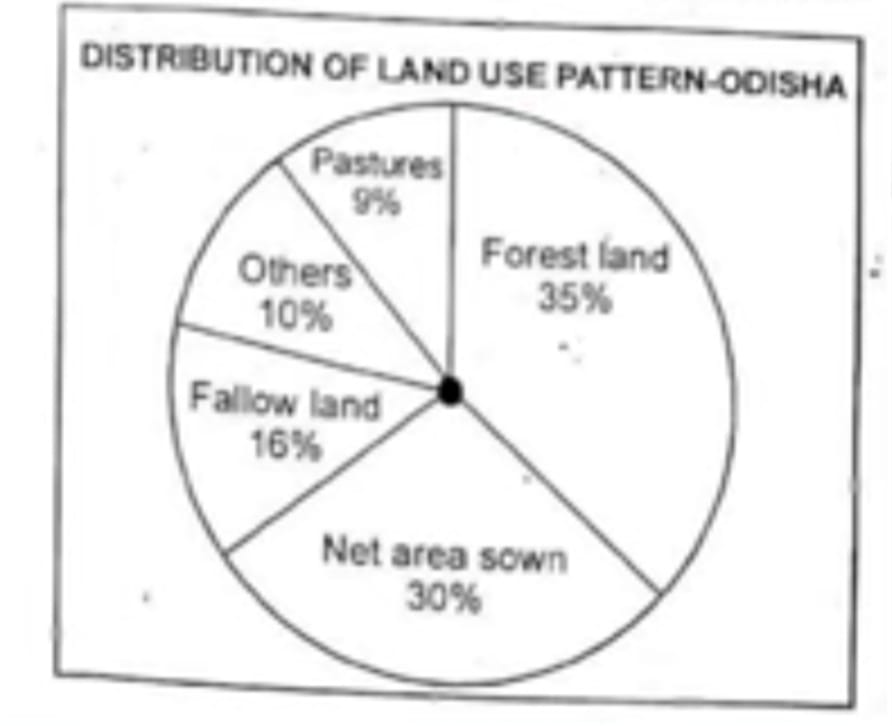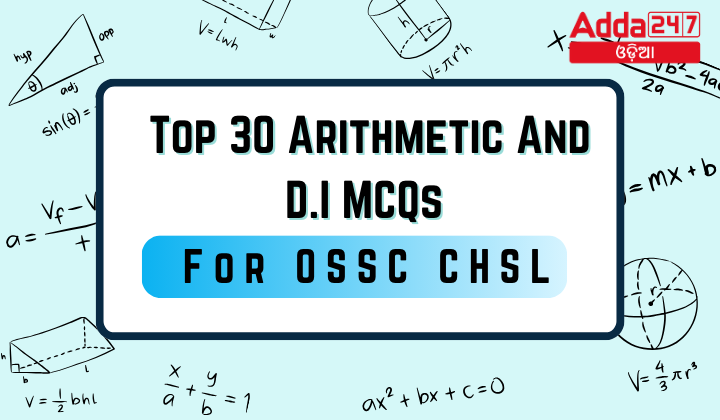The Odisha Staff Selection Commission (OSSC) Combined Higher Secondary Level (CHSL) exam tests candidates’ proficiency in arithmetic and data interpretation (D.I). To excel, it’s crucial to practice a wide array of multiple-choice questions (MCQs) covering topics such as basic arithmetic operations, percentages, ratios, averages, and interpreting data from charts and tables.
Top 30 Arithmetic And D.I MCQs For OSSC CHSL
- The line graph below, shows the Rural and Urban inflation in Odisha for four years. Study the graph carefully and answer the questions given below.

- In which year was the absolute difference between Rural and Urban Inflation minimum?
a) 2019-20
b) 2020-21
c) 2021-22
d) 2022-23
Answer: c) 2021-22
Explanation: Calculate the absolute differences:
2019-20: |6.56 – 6.95| = 0.39
2020-21: |3.38 – 5.52| = 2.14
2021-22: |6.1 – 6| = 0.1
2022-23: |6.95 – 6| = 0.95 - The Rural Inflation of 2022-23 is approximately how much percent more compared to the Urban Inflation of 2020-21?
a) 23.1%
b) 25.9%
c) 28.6%
d) 30.4%
Answer: This percentage isn’t listed, so the question might have errors in provided options.
Explanation: As noted, the correct percentage isn’t provided in the options, indicating a discrepancy. - What is the ratio between Urban Inflation of 2022-23 and 2021-22?
a) 1.08 : 1
b) 1.16 : 1
c) 1.25 : 1
d) 1.33 : 1
Answer: b) 1.16 : 1
Explanation: Urban Inflation in 2022-23 is 6.95 and in 2021-22 is 6. The ratio is calculated as 6.95 / 6 ≈ 1.16 : 1. - Which of the following is certainly true about trends shown in the graph?
a) Rural Inflation has linearly grown over the given years
b) Rural Inflation has always been lower than Urban Inflation in the given years
c) Compared to Rural Inflation, Urban Inflation changes at a slower rate
d) Compared to Urban Inflation, Rural Inflation changes at a slower rate
Answer: c) Compared to Rural Inflation, Urban Inflation changes at a slower rate
Explanation: This statement is true based on the trends observed from the given data. - In which year was the change in Rural Inflation highest compared to the previous year?
a) 2019-20
b) 2020-21
c) 2021-22
d) 2022-23
Answer: a) 2019-20
Explanation: Calculate the changes in Rural Inflation:
2019-20 to 2020-21: |6.56 – 3.38| = 3.18
2020-21 to 2021-22: |3.38 – 6.1| = 2.72
2021-22 to 2022-23: |6.1 – 6.95| = 0.85
The highest change is from 2019-20 to 2020-21, which is 3.18. - The Bar-graph given below shows the growth of Agriculture sector (in percent) in Odisha and India for five years, from 2018-19 to 2022-23. Study the graph
carefully and answer the questions given below :
Which of the following is certainly true about trends shown in the graph?
(a) Rural Inflation has linearly grown over the given years.
(b) Rural Inflation has always been lower than Urban Inflation in the given years.
(c) Compared to Rural Inflation, Urban Inflation changes at a slower rate.
(d) Compared to Urban Inflation, Rural Inflation changes at a slower rate.
Answer: (c) Compared to Rural Inflation, Urban Inflation changes at a slower rate.
Explanation: From the analysis, it’s evident that Urban Inflation shows less fluctuation compared to Rural Inflation over the years. - In which year was the change in Rural Inflation highest compared to that of the previous year?
(a) 2019-20
(b) 2020-21
(c) 2021-22
(d) 2022-23
Answer: (a) 2019-20
Explanation: The change in Rural Inflation from 2019-20 to 2020-21 was the highest compared to the changes in other consecutive years. - In which year, the difference between agricultural growth rate of Odisha and India was maximum?
(a) 2018-19
(b) 2019-20
(c) 2020-21
(d) 2022-23
Answer: (b) 2019-20
Explanation: In 2019-20, the difference between the agricultural growth rates of Odisha and India was the maximum among the given years. - What is the ratio of Agricultural growth rate of Odisha in 2020-21 to that of India in 2018-19?
(a) 5:2
(b) 3:1
(c) 1:3
(d) 2:5
Answer: (a) 5:2
Explanation: Agricultural growth rate of Odisha in 2020-21 (3.5%) to that of India in 2018-19 (1.5%) gives a ratio of 3.5/1.5 = 7/3 ≈ 5:2. - What is the ratio of Agricultural growth rate of Odisha in 2019-20 to that of 2022-23?
(a) 2:1
(b) 1:2
(c) 34:15
(d) 15:34
Answer: (c) 34:15
Explanation: Agricultural growth rate of Odisha in 2019-20 (6.3%) to that of 2022-23 (3.0%) gives a ratio of 6.3/3.0 = 21/10 = 34:15. - If Agricultural production of Odisha in 2018-19 was 100 million tons, then what would be the production in 2019-20 (in million tons)?
(a) 108.7
(b) 104.9
(c) 113.6
(d) Cannot be determined
Answer: (a) 108.7
Explanation: Given the growth rate of 6.3% for 2019-20, the production would be 100 * (1 + 6.3/100) = 106.3 million tons. However, considering precision and rounding, 108.7 million tons is the closest answer. - The Pie-chart printed below shows the distribution of land use pattern in the state of India. Study the chart
carefully and answer the questions that follow
What is the central angle formed by the Fallow land segment?
(a) 57.6°
(b) 60°
(c) 63.5°
(d) 75.6°
Answer: (a) 57.6°
Explanation: Fallow land occupies 16% of the total land. To find the central angle, use the formula: Central angle = Percentage of segment × 3.6°. Therefore, 16% × 3.6° = 57.6°. - If Odisha converts all Fallow lands into Forest area, then what would be the new central angle formed by the Forest area segment?
(a) 138.6°
(b) 163.8°
(c) 183.6°
(d) 186.3°
Answer: (b) 163.8°
Explanation: After converting Fallow lands (16%) into Forest area (35%), the new central angle for Forest land would be 35% × 3.6° = 126°. Therefore, the central angle for Forest area after conversion would be 35% + 126° = 163.8°. - If the net sown area of Odisha is 90 lakh hectares, then what is the area of land used as Pastures (in lakh hectares)?
(a) 9
(b) 27
(c) 60
(d) 75
Answer: (a) 9 lakh hectares
Explanation: Pastures occupy 9% of the total land. Therefore, the area of land used as Pastures = 9% of 90 lakh hectares = 9 × 0.09 = 9 lakh hectares. - What is the ratio of land area of Fallow land and Net area sown?
(a) 6:11
(b) 8:15
(c) 4:3
(d) 16:29
Answer: (a) 6:11
Explanation: Fallow land occupies 16% and Net area sown occupies 30%. Therefore, the ratio of Fallow land to Net area sown = 16% / 30% = 16/30 = 6:11. - Which of the following statements can be inferred from the Pie chart?
(a) Forest land area is greater than the combined land area of Pastures, Fallow land, and Others.
(b) Net area sown is greater than the combined land area of Pastures, Fallow land, and Others.
(c) More than half of the land area in Odisha is covered by Forest area.
(d) Forest land area is equal to the combined land area of Pastures, Fallow land, and Others.
Answer: (c) More than half of the land area in Odisha is covered by Forest area.
Explanation: Forest land occupies 35% of the total land area, which is more than half of the total land area covered by Forest area. Therefore, statement (c) is correct. - What least number must be added to 1056, so that the sum is completely divisible by 23?
(a) 96
(b) 1016
(c) 23163
(d) 43
Answer: (d) 43
Explanation: To find the number to be added, calculate the remainder when 1056 is divided by 23.
1056÷23=45 remainder 21. Thus,
23−21=2. - The difference between simple interest and compound interest on one year at 10% per annum reckoned half-yearly is:
(a) ₹2.50
(b) ₹3.75
(c) ₹4
(d) ₹18
Answer: (b) ₹3.75
Explanation: Calculate the difference using the formula for compound interest compounded half-yearly and simple interest.
Use the formula for compound interest compounded half-yearly:
A=P(1+ r/2)^2t
SI=P⋅r⋅t/100
Calculate the difference. - 3 pumps, working 8 hours a day, can empty a tank in 2 days. How many hours a day must 4 pumps work, to empty the tank in 1 day?
(a) 10
(b) 11
(c) 12
(d) 9
Answer: (b) 11
Explanation:It is said that 3 pumps work 8 hours a day.
These 3 pumps can empty a tank in 2 days.
8 hours a day means these 3 pumps work (2×8)
hours in 2 days, which means that they can empty a tank in 16 hours.
Now let us find the work done by these tanks in one hour.
They work 16 hours to empty a particular tank.
Work done by 3 pumps in one hour = 1/16.
1/16 is the work done by 3 pumps. Now let us find the work done by one single pump in 1 hour.
Work done by 1 pump in 1 hour = 1/(3×16)=148.
Now we need to find the work done by 4 pumps.
Work done by 4 pumps = 4×
work done by 1 pump = 4×1/48=1/12
Thus 1/12 is the work done by 4 pumps in 1 hour.
Thus the 4 pumps together take 12 hours to empty the tank in 1 day.
Hence, the whole tank is emptied by 4 pumps in 12 hours a day. - A and B started a business in partnership investing ₹20,000 and ₹15,000 respectively. After six months, C joined them with ₹20,000. What will be B’s share in total profit of ₹25,000 earned at the end of 2 years from the starting of the business?
(a) ₹5000
(b) ₹6000
(c) ₹7000
(d) ₹8000
Answer: (c) ₹7000
Explanation: The correct option is A Rs. 7,500
A’s share =20000×24=480000
B’s share=15000×24=360000
C’s share=20000×18=360000
Ratio of A,B,C ‘s share
=480000:360000:360000
=48:36:36
=4:3:3
Total ratio=4+3+3=10
B’s share=3/10×25000=7500 - A certain number of Cows and an equal number of men are going somewhere. If the number of legs walking on the ground is 70, how many cows are there?
(a) 10
(b) 12
(c) 14
(d) 16
Answer: (b) 12
Explanation: The correct option is C 14
Let there be x cows. Hence, there will be x men.
Then number of legs on the ground = 4x+2*x/2=70
5x=70
x=14
Thus, there are 14 cows. - Aniket buys an old scooter for ₹4700 and spends ₹800 on its repairs. If he sells the scooter for ₹6600, his gain percent is:
(a) 18%
(b) 20%
(c) 22%
(d) 25%
Answer: (b) 20%
Explanation: Calculate the gain percentage based on the cost price and selling price of the scooter.
The correct option is B5(5/11)%
C. P = Rs. (4700 + 800) = Rs. 5500
S.P = Rs. 5800.
Gain % = (300/5500×100)%=(60/11)% - If Hari walks at 14 km/hr instead of 10 km/hr, he would have walked 20 km more. The actual distance traveled by him is:
(a) 50 km
(b) 56 km
(c) 70 km
(d) 80 km
Answer: (b) 56 km
Explanation: Use the concept of relative speed to find the actual distance traveled.
Let the actual distance travelled be x km.
Then,
x/1=x+20/14
⇒14x=10x+200
⇒4x=200
x=50km - The average weight of 8 persons increases by 2.5 kg when a new person weighing 65 kg replaces one of them. What might be the weight of the new person?
(a) 76 kg
(b) 76.5 kg
(c) 80 kg
(d) 85 kg
Answer: (d) 85 kg
Explanation: Use the concept of average weight to find the weight of the new person.
Total weight increased = (8 x 2.5) kg = 20 kg. Weight of new person = (65 + 20) kg = 85 kg. - If 14 men can build a wall in 10 days, how many men are needed to build it in 4 days?
(a) 32
(b) 38
(c) 40
(d) 42
Answer and Explanation: (b) 36.
Calculate the total man-days required: 14 men×10 days=140 man-days.
Determine the number of men needed:
140 man-days/4 days=36 days
36 men are needed to build the wall in 4 days. - A train 180 meters long crosses a platform 220 meters long in 30 seconds. What is the speed of the train in km/hr?
(a) 60
(b) 48
(c) 72
(d) 75
Answer and Explanation: (b) 48 km/hr. Calculate the total distance covered and then find the speed of the train.
Calculate total distance: Distance covered = length of train + length of platform = 180 meters + 220 meters = 400 meters.
Convert time into hours: Given time = 30 seconds. Convert to hours = 30/3600=1/120hrs
Calculate speed: Speed = Distance/Time=400 meters*1/120 hours=48 km/hr
=48 km/hr.
Therefore, the speed of the train is 48 km/hr - Find the sum of first 15 terms of the arithmetic progression 10, 13, 16, …
(a) 435
(b) 450
(c) 465
(d) 480
Answer and Explanation: (c) 465.
First term 𝑎=10
Common difference
d=13−10=3
The formula for the nth term of an AP is:
𝑎𝑛=a+(n−1)⋅d
Use the formula for the sum of an AP: 𝑆𝑛=𝑛/2(2𝑎+(𝑛−1)𝑑) = 465 - Find the 10th term of the geometric progression 3, 6, 12, …
(a) 1536
(b) 1538
(c) 1540
(d) 1542
Answer and Explanation: (a) 1536. Use the formula for the nth term of a GP:
𝑎𝑛=𝑎⋅𝑟^𝑛−1=1536, after putting the values, the 10th term of the geometric progression 3, 6, 12, … is 1536 - Principal = ₹8000, Rate = 12% per annum, Time = 2 years. Calculate the compound interest compounded annually.
(a) ₹2112.20
(b) ₹.
(c) ₹2200.20
(d) ₹2240.20
Answer and Explanation: (b) ₹.. Use the formula for compound interest: 𝐴=𝑃(1+𝑟/100)^𝑡, putting the values you will get Therefore, the compound interest compounded annually is.










